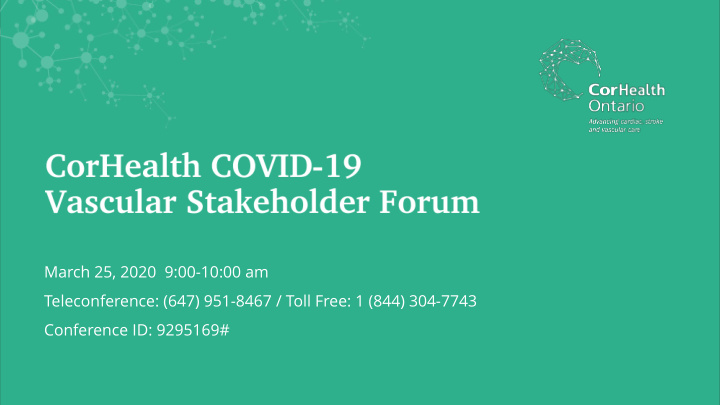



March 25, 2020 9:00-10:00 am Teleconference: (647) 951-8467 / Toll Free: 1 (844) 304-7743 Conference ID: 9295169#
Description Presenter Time 1. Welcome System Planning Updates Sheila Jarvis 09:00 • Meeting Objectives • 2. MOH Memo, March 15, 2020 Dr. Sudhir Nagpal 09:10 Elective Surgeries and Other Non-Emergent Activities • 3. Prioritization of Vascular Procedures and Services Dr. Sudhir Nagpal 09:15 4. Outpatient Clinics Dr. Sudhir Nagpal 09:45 5. Next Steps All 09:55 2
SHEILA JARVIS
• COVID-19 landscape is rapidly evolving • Keeping front line health care providers healthy is vital as we manage the COVID-19 pandemic. • Minimizing the impact of COVID-19 on the mortality and morbidity of patients with vascular disease is a priority • Province and hospital specific infection prevention and control policies and protocols exist • Promoting clinical activities aimed a preserving hospital resources (i.e. health care human resources, PPE, ICU’s, ER’s) is also a priority. 4
Urgent and emergent vascular procedures are still being performed across • vascular centres in Ontario Vascular programs will need to balance vascular procedures requiring ICU, • prolonged intubation and admission with the availability of ventilators, as well as hospital bed resource allocation to maximal safety for patients and medical personal. EVAR and endovascular therapy may be a preferred option due to reduced • post-operative resources required. Repatriation should be a significant priority away from tertiary care centers • to allow the preservation of resources in receiving hospitals. 5
1. To understand whether vascular programs have already begun to develop guidance documents for selection of vascular patients that must have surgery during the COVID-19 outbreak. 2. To identify the need for provincial guidance documents for selection of vascular patients that must have surgery during the COVID-19 outbreak. 6
DR SUDHIR NAGPAL
• “ Each hospital, health system, and physician should review all scheduled elective procedures with a plan to postpone or cancel electively scheduled operations, endoscopies, or other invasive procedures until such time that hospitals are able to accommodate these additional procedures.” • “ Non-emergent activity should be reduced in a step-wise manner in order to preserve, to the greatest degree possible, access for time-sensitive care. This would include, but is not limited to: • Time-related disease like certain cancers, particularly if the outcome is treatment-related; • Cardiac procedures for which there is risk of significant morbidity or mortality if delayed; and, • Non- emergent activity that will or may convert to emergent.” • Immediately adopt a stewardship approach to minimize use of essential items needed to care for patients , including but not limited to: ICU beds, PPE, cleaning supplies, and ventilators. 8
DR. SUDHIR NAGPAL
• What elective surgery procedures are vascular programs cancelling or deferring? • Who and how is triaging/prioritization decision making occurring? • What will remain scheduled? • What clinical scenarios are being cancelled or deferred? • Have any centres developed triaging/prioritization protocols or decision aids? If yes, are you willing to share your programs decision aid(s) with CorHealth and other programs? • • Would it be helpful if a provincial triaging/prioritization decision aid was produced and circulated? If yes, a re you willing to have your program’s decision aid integrated into a provincial summary • document? 10
PROCEDURE Priority Priority Wait Time AAA symptomatic A Fistula Declot A A Emergent/inpatient TBAD with malperfusion A Mesenteric angio/bypass A/B B < 2 weeks Amputations B Bypass/Angioplasty - Gangrene/Ulcer B C 2-4 weeks Carotid symptomatic for (CEA/CAS) B Femoral or Popliteal aneurysm, Symptomatic B D 4- 8 weeks Fistula Revision for Malfunction B Fistula Revision for Ulceration B Thoracic Outlet Syndrome, Arterial with thrombosis B E >8 weeks Wound Debridement B AAA Men >7cm B/C AAA Women >6.5cm B/C Bypass/Angioplasty - Rest Pain B/C Thoracic Outlet Syndrome, Venous with thrombosis B/C TAAA >7cm C Do the priority levels in this sample guide AAA Men 6-7cm D align with prioritization established by your AAA Women 5.5-6.5cm D hospital/ vascular program? Fistula Creation, on HD D TAAA 6-7cm D TBAD with high risk features D AAA Men 5.5-6.0cm E AAA Women 5.0-5.5cm E Bypass/Angioplasty - Claudication E Carotid asymptomatic >80 for CEA or CAS E SOURCE: table is adapted from data/communications with Vascular Femoral or Popliteal aneurysm, Asymptomatic E Surgery at the Cleveland Clinic, provided through the Society of Fistula Creation, not on HD E Vascular Surgery (SVS) Thoracic Outlet Syndrome, Neurogenic E 11 Thoracic Outlet Syndrome, Venous otherwise E
• In the event that your vascular program encounters physician staffing issues, should there be discussions about cross-credentialing vascular specialists at other vascular hospitals to increase the HHR support? 12
DR SUDHIR NAGPAL
• Are centres decreasing outpatient clinic volumes? o Which clinics? • Are virtual/telemedicine care scenarios being used as a replacement to some or all of the clinic visits? • Do you have concerns about access to vascular labs or non-invasive testing? 14
• CorHealth activities • Future meetings 16
Recommend
More recommend